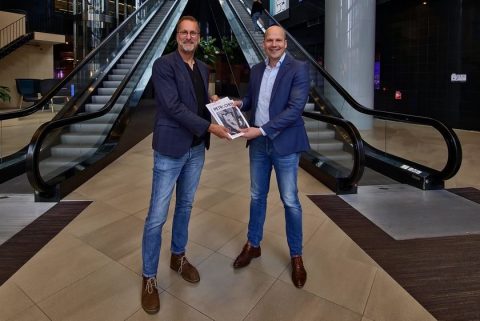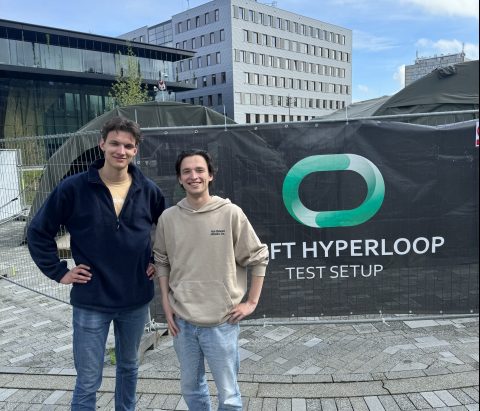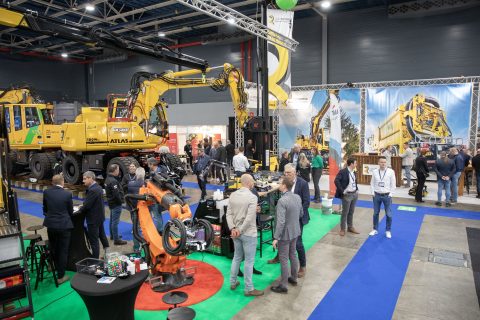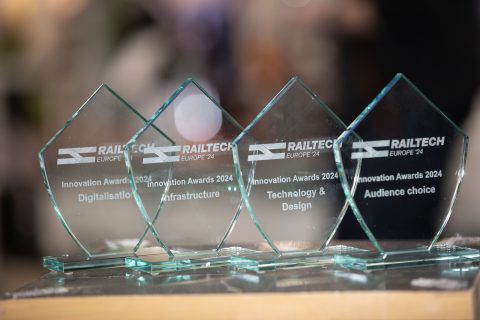RailTech Innovation Awards – Q&A with Move Intermodal

RailTech Europe 2017 event in Utrecht was a resounding success – and one of the highlights was undoubtedly the Innovation Awards, presented to a host of companies and individuals for their innovative work in rail technology. Today we launch a series of Q&A interviews with some of the winning companies.
We kick things off with Move Intermodal, winners of the Rail Cargo category. Answering the questions is Commercial Director Tomas Templaar, who is seen here (centre) with colleague Hans van Maanen, Fleet Control Manager at Move (right), receiving the award from Rolf Dollevoet, Professor of Railway Engineering at the Technical University of Delft in The Netherlands.
What would you say is the “ethos” of your company/organisation? “Move Intermodal aims to be the leading director for sustainable synchromodal transport solution in Europe.”
Please tell us a little about the project you submitted for the RailTech Innovation Award. How did you come up with the idea?
“Because of environmental and congestion issues, Europe strives for a modal shift policy. Within the continental intermodal traffic there are 3 types of load units:
1 – Closed ISO container
2 – Curtainside swap bodies (tilt swaps)
3 – Crane-able trailers
“Each of the 3 units has its own advantages and disadvantages. Tilt swaps serve the same markets as crane-able trailers. The trailers are put rail on specially-built wagons, whereas tilt swaps can use the same wagons as ISO containers. This makes the tilt swap more practical for rail transport because the required wagons are widely available, lighter, cheaper and more efficient in length. Just as with a truck, the total length and weight of a train is limited. By optimising the length and weight, more cargo can be transported at the same cost. Move Intermodal, together with its partner Wecon, has developed an improved and moreover lighter tilt swap to increase the modal shift.”
In your experience, what are the biggest barriers to getting new innovations out into the wider market?
“That fully depends on the impact of the innovation on the market and customer benefits. Therefore, we strive for practical innovation, which can directly benefit our customers. When they can see the benefit, the market adapts easily to the innovation.”
Why did you put yourselves forward for the award?
“Because the concept of the light swap body doesn’t only benefit the customer and Move. It can have a good contribution to modal shift in general thus contributing to every business’ corporate social responsibility program and Europe’s sustainability goals.”
Is there more that could be done – for example, government policy, more funding – to help businesses with developing new ideas?
“Companies should be willing to work together on innovative concepts/project. Combining one another’s knowledge will lead to much better solutions for the end customer. 1+1 = 3.”
Where do you see your innovation in five years’ time?
“On mature rail corridors it will be the preferred type of equipment to carry out door-to-door transports.”
Can you tell us about any other exciting projects in development?
“Nowadays a lot of continental dry bulk shipments are carried out via 30ft bag-in-a-box containers (a container with an inner liner). This works on corridors which are equally balanced in terms of bulk reloads on both sides. However when there is an imbalance, a lot of empty repositioning is needed. A 45ft bag-in-a-box container would increase the possibilities to reload the containers with normal FTL packed cargo, increasing the amount of full kilometres.”
For more information about Move Intermodal visit the company website.




